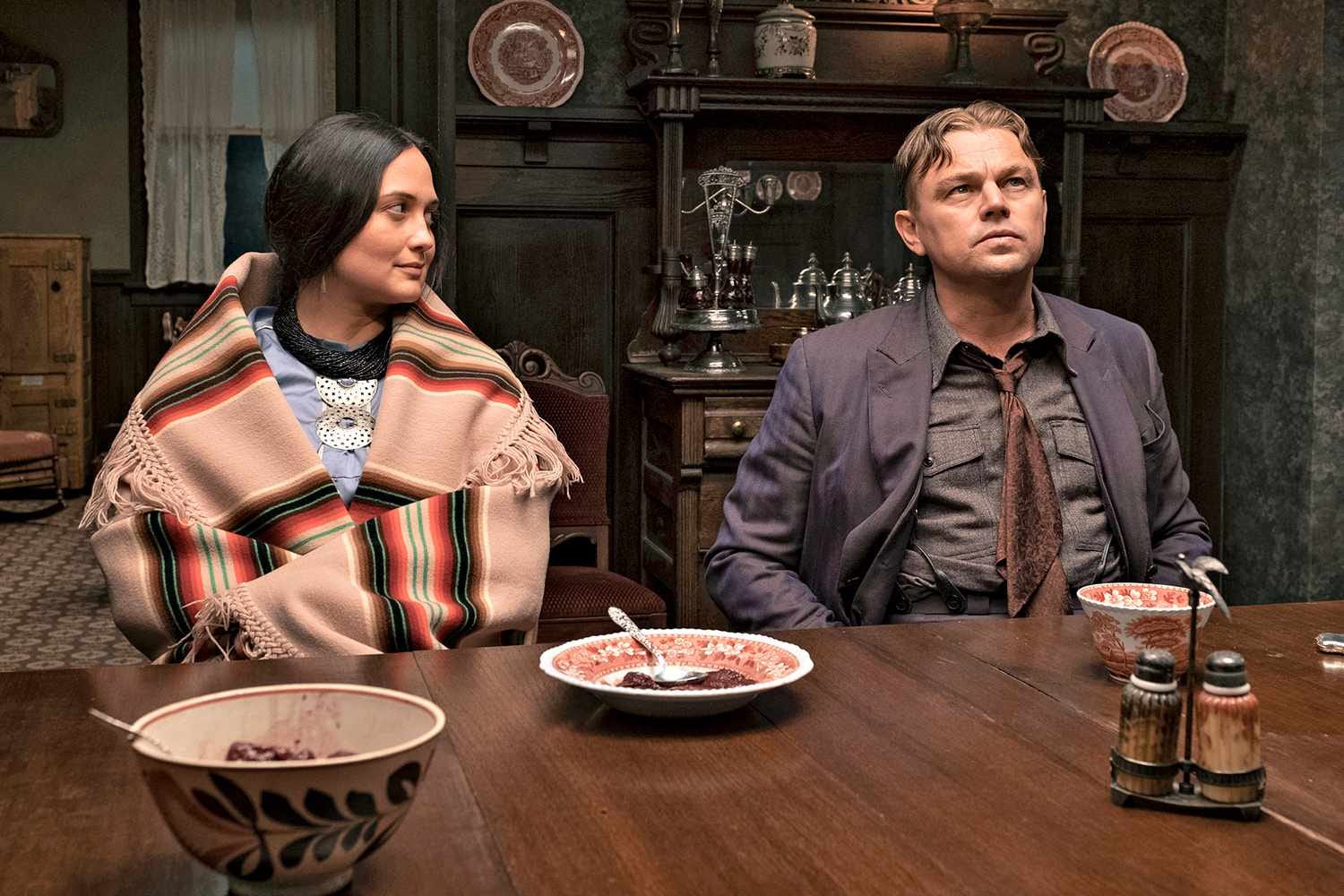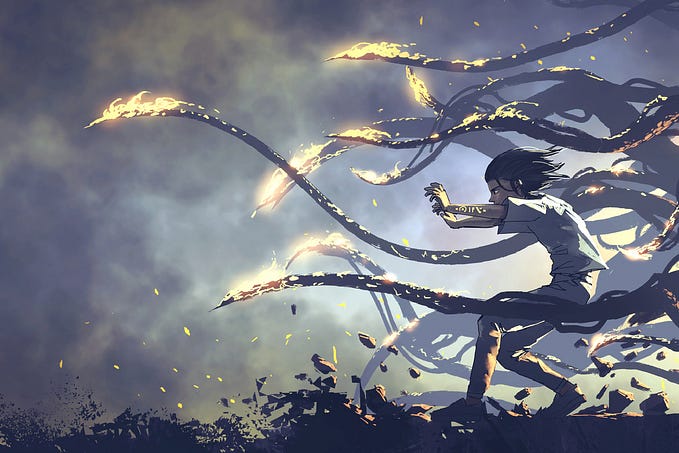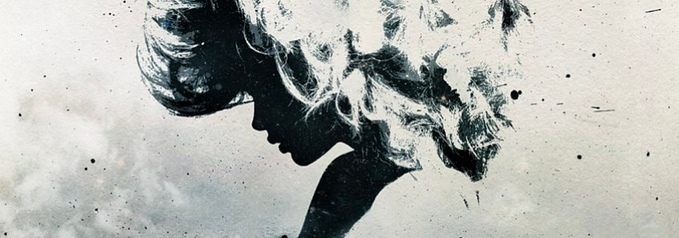Paper “Moon”: Killers of the Flower Moon
Why I hated and felt cheated by Martin Scorsese’s latest

Killers of the Flower Moon is bookended by two images- a look towards the god and a view from their vantage point”. Martin Scorsese opens with the camera peering upwards, hands hovering over the lens, at the ceremonial honoring of a dead Osage Medicine Man in a tent. The viewer gazes up at the loss of a generation’s knowledge and history that has been ravaged by white violence. The weight of that loss hovers on the horizon like the diffused light pouring in from the top of the tent. But at the close of the film Scorcese chooses a shot from above, gazing down at a gathering of Osage people joined in circles together, ringing around like the years on a tree stump. This is what remains of them. They live on. But looked down upon? By a white God that has swallowed up their culture? By an audience who has implicitly benefitted from their displacement? Or by a director who thinks he’s transmuted his anxieties and guilt to the hereafter?
Anne Thompson: You threw away the whodunit aspect from the book. And told us from the beginning what was really happening.
Scorsese: Because it doesn’t matter who did it? They all did it.
Anne Thompson: So it’s why they did it?
Scorsese: Well, what is in us that makes us do that? What is our flaw in our own human nature, that makes us take advantage of others, that sees us as superior? Being one of them too, European American, of course, I come from a southern climate, Sicily, a little different from northern climates in Europe and Scandinavia. So many people came over as as immigrants, as settlers. And there was an ethic of you sow and you reap. You work, and then God blesses you with rewards.
It just doesn’t seem right, from the point of view of that group of people from Europe. “Why should these people [the Osage] who don’t work, suddenly be blessed with all this richness, because it comes out of the ground? First of all, they’re not Christian. They don’t know anything about how to handle money, what money is.”
Grann’s book focuses largely on the birth of the Bureau of Investigation — now known as the FBI — and specifically on one of its most upstanding agents, Tom White (played by Jesse Plemons). Originally, DiCaprio was supposed to play White. But something about that framework bothered both him and Scorsese. “After a certain point, I realized I was making a movie about all the white guys,” Scorsese says. “Meaning I was taking the approach from the outside in, which concerned me.” Eventually, he and DiCaprio realized that the heart of the movie wasn’t the birth of the FBI, but the love story between Ernest and Mollie. That became the film’s core.
And the way in which the couple’s relationship is reimagined, as Scorsese made clear to me, embodies his own grappling with the underlying morality of Grann’s tale — a responsibility to place the Osage people at the center of the story that turned out to shift the very aesthetic of the movie.
It was the perfect set-up for a murder mystery, but something didn’t feel right. Scorsese, DiCaprio and De Niro began to realize that the situation was more complex than that. More explicitly, it would be inappropriate to serve up a white-savior Western since white people were also the bad guys: the outsiders who insinuated their way into the Osage and took advantage of their naivety, empowered by apathy from corrupt local law enforcement and townsfolk eager to shake money out of the pockets of their trusting Osage friends.
Scorsese: We only became fully aware of what happened in Tulsa [Massacres of 1921] a couple of years ago. We knew about race riots, about lynchings. We didn’t know about the destruction, the wiping out of a whole people out of fear of economic superiority, of people of a different color. You see they’re doing well and next thing you know… I think it has to come down to pure racism. This country’s a big experiment. Everybody’s together.
Scorsese: Maybe because where I came from, I saw it on street level, I think. A lot of it has to do with believing that you’re right, believing you deserve it. And that’s what I’ve been becoming aware of in the past twenty-five, thirty years of the country based on people who formulated the country, white Protestant — English, French, Dutch, and German. And so that country was formed that way with that kind of thinking. It’s European, but not Catholic, not Jewish, but the work ethic of the Protestant, which is good. It’s just that that was the formation. And then the political and power structure came out of that and stays with that. It just stays with it. I also saw and experienced people close to me who were basically pretty decent, but did some bad things and were taken advantage of by law officers. So I grew up thinking there’s no lawman you could trust. There was some good police, there were some good cops on the beat, nice guys. Some were not. But, from my father’s world, from his generation, it was a very different experience.
People love using the word “reckoning” when writing about Killers of the Flower Moon; you can find it here, here, here, here, and here. Scorsese and those writing about him have been big into using the word “complicit”, too, seen here, here, and here. Such is the tone of all the rah rah-ing for the legacy director’s latest offering, another piece of work signaling the octogenarian filmmaker’s hyper self-reflective streak of late: The Irishman is filled with the loneliness and isolation of a criminal force to sit with what he’s done and the missionaries in Silence face the brute reality of being agents of Imperialism. Meditatively melancholy and coming to terms with the shortening fuse on life he has, it’s time for everyone’s favorite tentpole zeitgeist skeptic and online cinephile grandpa to reflect on his own part in white supremacy. Bravo.
If one wants to disregard the press around the film as the necessary evil of promoting a work of art, then fine. But rather than perpetuate a discourse that risks exploiting the contributions of the Osage people merely as progressive brownie points, it might just be worthwhile to think about the film itself. To engage with what it’s actually doing. Of course we should do that, seeking that sweet spot between context and art object vacuum.
When the film begins, we are immediately placed within the world of the Osage, from the death of their Medicine Man to the bursting geyser of oil to the uncanny Kinoscope images of the new wealth that has changed their lives materially (if not necessarily politically), there is the beautiful and exciting feeling of, for lack of a better word, resurrection. Even if these are recreations, fictions drawn up from the archive, there’s a wondrous sense of intimacy and detail in clothing, code switching, the melding of tradition and modernity, with the hope that history will continue to live on through these monochromatic images.
But just as quickly, we’re wrenched out of this tourist’s guide through Osage’s oil wealth. The silent film reel widens its aspect ratio and transforms into a slow push-in towards Leo’s frowning face on a train. A change in who we’re looking at or who’s looking or both? Was he the one watching those reels, playing them over in his head before arrival into Osage land? That appears to be written in the text, a conscientious effort to turn these scenes, dioramas, and even in the abominable early deaths into tableaux. These compositions feel like Scorsese giving the Osage people the time to process on screen white brutality on a gigantic scale and on more their own terms than had previously been achievable given the racist Hollywood and filmmaking industry.
When we’re taken out of the world of the Osage as they have carefully conceived of it (for Marty’s camera), the permanent inverted rictus is already affixed to Ernest Brukhart’s face. Leonard DiCaprio seldom molds his mouth in any other way through what feels like almost all 3 hours and 47 minutes. His maw is resolute in that position, as if Ernest could not imagine his facial muscles landing in any other resting position, and Leo couldn’t fathom playing it any other way. (As a person of resting scowl face, I sympathize.) When he lands after WWI in Osage County, his uncle King William Hale (De Niro) takes all of 30 seconds before placing the seeds of genocide in the supposed lunk’s head. Ernest can’t work, likes women, and loves money, a real gold digger also prone to crime. King incepts the idea of marrying one of the Osage women for their money, encouraging him to do his research to assimilate enough to make himself appealing to one of these women. Eventually he begins serving as the driver for the sharp and self-possessed, but diabetically prone Mollie Kyle. They hang out twice and then are married, and in the next scene they have a child.
Meanwhile, members of the Osage Nation are turning up dead with little to no explanation. Scorsese shoots these scenes of violence and then briefly watches them sleep forever. The names and ages of the first several victims are narrated by Lily Gladstone, presumably as Mollie, as a source of fury, of mourning, and perhaps even as bridge between this and the next life.
If Killers of the Flower Moon’s gaze isn’t on victims of the drawn out massacre, it is turned to primarily Ernest and King, the older man whispering little orders into the alleged idiot’s ear like Google Nest. DiCaprio as Ernest listens and nods his head and says yes. For him, there’s nothing to wrestle with; he just goes and does what he is told, whether it’s by someone he fears, or loves, or both. Everyone else in the town either lands on one of two sides of the wicked coin: either actively compartmentalizing/rationalizing their racist and murderous behavior to go on as if nothing is happening, or evil enough to not care about the rationalization part. But DiCaprio finds himself in a pickle to keep the film to be dramatically interesting. In order for the horror of Ernest’s actions to register as coherent, one of two questions must be asked: how can this man go on rationalizing his actions? OR how can this man have rationalized his actions?
It’s a subtle but meaningful difference. We are either going on the emotional and intellectual journey of watching someone in the process of doing something evil, seeing how the gears turn in the lifespan of a decision. Or we are watching the actions of someone who has already made that decision, placing dramatic focus on the consequences they’ve not yet experienced. Either way we are waiting for the grenade to detonate when the pin has already been pulled. But the former is pulling the pin, the latter is watching it fly through the air and land.
DiCaprio never plays the character as if Ernest has ever doubted anything. It’s hard to say whether it’s impulse, but he’s clearly not a deep person. He just does things. He’s hungry like a wolf. Or, better yet, a coyote, as Mollie calls him. He sees what he wants and gets it by any means necessary. We’re are lead to believe that this is why Mollie loves him, that his hunger balances her serenity. She knows he’s a coyote and loves him for it. He wants to be tamed, she says.
We’re lead to believe that Ernest is stupid enough to not know he is committing, at least, a basic betrayal by killing her family members and community But the relationship between them is so hazily sketched that it’s difficult to believe that she wouldn’t smell the blood on his clothes. If the question at the center of the movie, too, is how could Mollie love a man who is betraying and harming her, our insight into their relationship is limited to two courting scenes, a marriage proposal, and the sudden introduction of children. There are few occurrences where we see what their relationship looks like on their own terms as frequently the scenes we get of the two of them are inextricably tied to the dynamic between Ernest and King. There’s no scene to get a grasp on what their dynamic is like. There’s no scene of them just together at home without some tie to an outsider. There’s no scene of Ernest loving Mollie for who she is, outside of the whispers from King. There is no scene where we understand how Mollie rationalizes her love for Ernest. There is no scene in which we see Ernest bring in the outsiders into their home. In other words, there is no scene in which their love is particularly believable within the film’s logic. So finally, when he begins poisoning her, deluded, there is nothing behind DiCaprio’s eyes.
So, fine, it’s mostly about Ernest and King, the pack of wolves that tear through an entire farm, the camera wearing the sheep’s clothing. As an interrogation of racist white cognitive dissonance, it wouldn’t be the first flop. Every big shot director gets a self-flagellation opus where they apologize for their complicity: Sofia Coppola has The Beguiled, Alfonso Cuaron’s got Roma, Steven Spielberg revamped West Side Story, etc. While Scorsese’s usual impulse to systematize culture and society — the hierarchy of gangsters in GoodFellas, the violenc eof polite Gilded Society in The Age of Innocence, the mob machinations of Casino — actually exhibits itself in its interesting panorama view of the Osage Nation at the beginning of the film, it spreads out and feels more at home from that of the community that’s doing the killing So be it; if that’s what the director is good at, then do it. You gotta get a gimmick, Sondheim once wrote.
Yet, there is constantly this tension of authorship, insofar as where and when Scorsese cedes his gaze in favor of Osage interiority. Mollie’s voiceover steps in twice after the initial name readings, articulating her helplessness and the evil she sees around her, her heart on the edge of being consumed by hate. We briefly see through her eyes as a virus spreads in the town, multiplying like a cancer. We witness her mother Lizzie (Tantoo Cardinal) spot an omen in an Owl through the ailing woman’s eyes, and then again through Mollie’s gaze. We are, for select moments, granted access to their spirit and soul. And then that is taken away from us, replaced with another scene of death or scheming or action borne out of fear or greed.
Why bother? Lily Gladstone is one of the best actors we have, her face unpredictable in her ability to be at any moment placid and opaque or her emotions totally legible. Voiceover attempts to give the explicit indication that the film’s perspective and subjectivity is changed. But it doesn’t really; instead it roams haphazardly between three gazes: Mollie’s, the Osage’s, and Ernest’s- the dominating view of the film. But if this is supposed to represent the anxiety and tension of the film’s authorship itself, it’s bizarre that this isn’t built into the film more textually: the view we get of the Osage people is not through Ernest’s perspective. It exists to both directly challenge racist and white supremacist depictions of Native Peoples, but to overtake and assert their history and point of view almost meta-textually. Yet if we’re supposed to believe that this is a movie that is consciously, self-reflexively ambivalent about its authorship, why is it then that self-reflexivity only really kicks in at the movie’s coda? There the man himself appears to read Mollie’s obituary in a radio show that seems to also satirize the spectaclizing of violence? If the function of this bouncing inconsistently between points of view, then why is that seemingly only articulated and justified in the film’s final moments, long after audiences are granted access to the beds on which the dead Osage lay.
This is less of a love triangle of competing interests and ideologies, Ernest caught in the middle (or Gladstone, depending on your reading), but a movie that has lost sight of its shape and how it triangulates power both in the micro and in the macro. Simply because its perspective of how those lines of power are drawn is unbearably uneven.
It’s fair to ask what a movie made from this vantage point of power yet still wanting to confront the complicity of its author would look like. How do you give enough space to a Native Community to assert their own humanity while also telling the story you want to tell? I don’t have the answer to that, although I think part of it would mean being a bit more honest about where the focus is supposed to be and for there to be clearer delineations of how that is executed. What does a reckoning on film even look like? If it’s a story about one person in a marriage standing in for the betrayal against a people, there’s such lack of depth to the husband it’s as if that parts of the wife were used to fill it out, to add more flesh and blood where there was drought.
But, blah blah, progressive values need not be the premise of art, good or bad. But a cohesive or coherent framework is a rule that most, if not all, art abides by. It knows what it’s saying and how to say it. Killers of the Flower Moon claims to say one thing and then says a bunch of other things. The competing voices in the movie do not give balance or harmony to the story, but convolute it beyond aesthetic and ideological comprehension. Anyone trying to claim that to take issue with the film on the grounds of how it articulates its perspective in relation to how it portrays the Osage people is infantile, I feel, is deeply suspect. I never asked for a progressive politic, i asked for a direct one, one that approximates cohesion, unity, or balance. That is not what is here. And it’s frankly appalling to say that people who seek for that are doing so under some neolib representational excuse. My point is that Scorsese’s relationship to the Osage people in the film and the way he selectively grants them depth and interiority is disingenuous, particularly when his lead barely has any of that fertile ground, even on the grounds of the gradations of the toxicity of white supremacy.
The single scene that is most representative of Scorsese’s inclination to speak from both sides of his mouth is the rainstorm scene, the first date. It’s where and when Mollie sizes up Ernest, recognizes him for what he is and negotiates her own attraction to that. The single available press image of the two sitting side by side at the table was fodder for jokes about the secrecy of the film’s real content. But there Mollie is, asserting her strength, getting Ernest to quiet down and to listen. She tells him to be quiet for a while for the rainstorm. And he sits there, struggling. But before we have the chance to truly be in the moment with both of them, after Ernest has ceded his own desires for her, the only selfless act he makes, before we can take in the sound of the raindrops beat like a drum on the roof and sit with those characters’ silence, Scorsese cuts to an exterior shot. It undermines and defuses the moment and the power that Mollie speaks of. The film never recovers. Neither does she.
There’s just such a lack of cohesion and rhythm to why we are seeing the film’s story told from any particular point of view, that, not unlike Barbie, betrays its filmmaker’s own anxiety about how to negotiate politics. Whether as a thing to obfuscate from the this that has the most gravitational pull on the artist or as a way to make some kind of mild reparations, there is only as much insight into the Osage people and Mollie in particular such that it left me with a tantalizing taste of a different movie that Scorsese seemingly has less interest in. It’s fine if that’s the case, if he’s drawn to the psychosexual and sadomasochistic father/son thing going on with Ernest and King. But at least be honest about that, about being dedicated to exploring (and supposedly interrogating) their criminality, racism, evil. Those are legitimate topics for cinema, in their banality and gargantuaness. But here, it feels paper thin.










